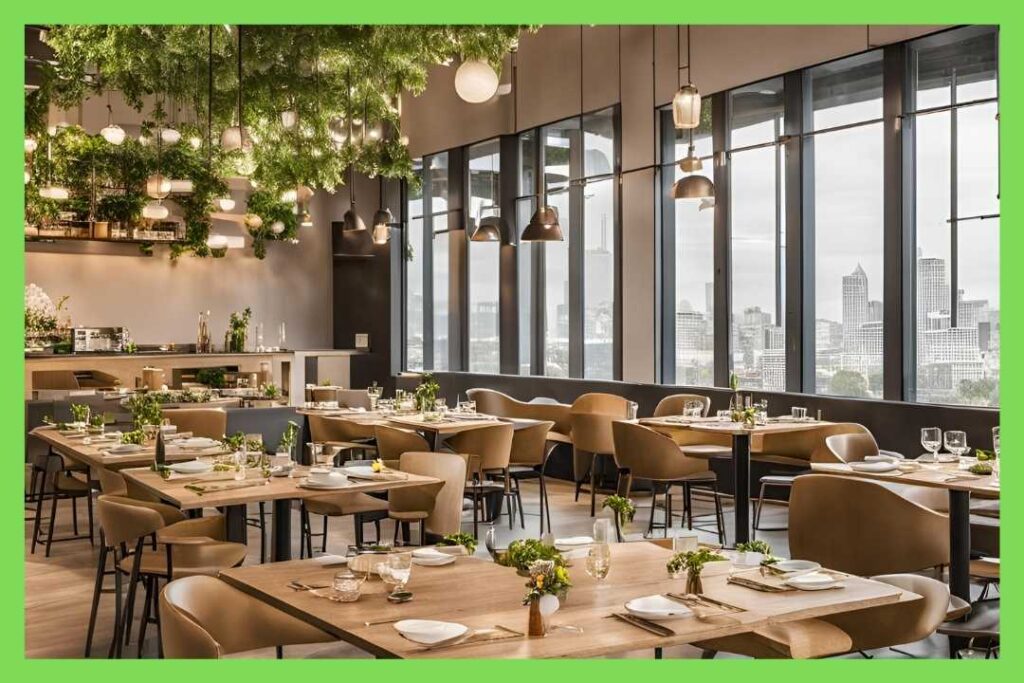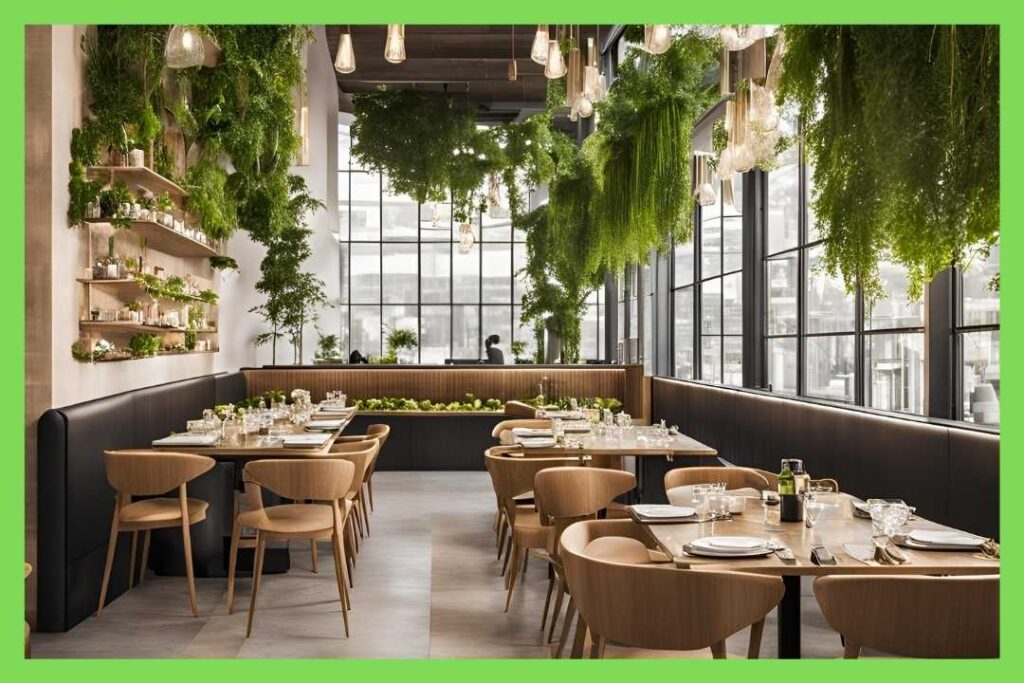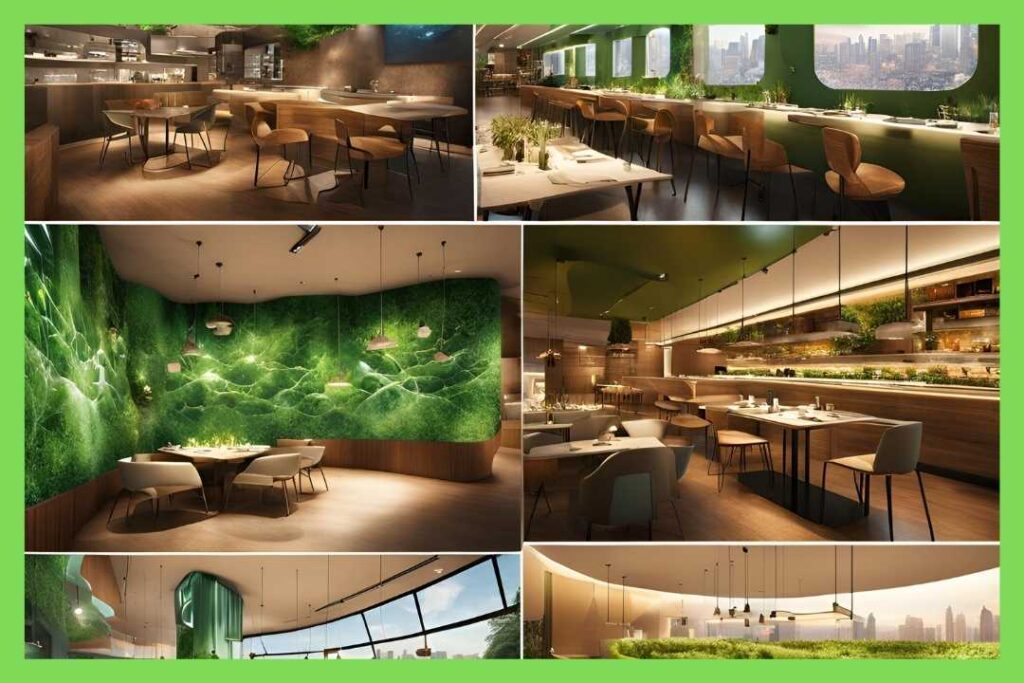The world is waking up to its environmental impact, and restaurants are leading the way. In 2024, eco-friendly restaurants will change how we dine. They will offer a new experience for those who care about the planet.
Let’s explore the latest trends in sustainable dining. We’ll see how restaurants will use more plant-based menus and reduce waste. This will make dining not only good for you but also for the planet.
Embracing Plant-Based Menus

Eco-friendly restaurants are now offering more plant-based options. They use meat alternatives and seasonal produce to make tasty and sustainable cuisine. They serve everything from creative plant-based burgers to dishes full of local veggies.
From Innovative Meat Alternatives to Seasonal Produce
Restaurants focused on the environment are trying new things with plant-based menus. They use advanced meat alternatives to make old favorites better. They also use locally sourced and seasonal produce to make their food both tasty and good for the planet.
Exploring the Flavors of Sustainable Cuisine
The growth of sustainable cuisine has opened up new culinary adventures. Eco-friendly restaurants mix old ways with new ideas to create amazing dishes. They highlight the beauty and taste of plant-based foods, impressing those who care about the environment.
“The future of dining is not just about satisfying our hunger, but about nourishing our planet as well. Eco-friendly restaurants are leading the way, proving that sustainable cuisine can be both delicious and environmentally responsible.”
Locally Sourced and Organic Ingredients

Eco-friendly restaurants are changing how we eat by focusing on local and organic ingredients. They work with nearby farms to serve fresh, quality food. This cuts down on the harm caused by long-distance food transport.
Supporting Local Farmers and Reducing Food Miles
Choosing local ingredients helps these restaurants reduce their carbon footprint. It also helps local farmers a lot. They get to work with restaurants, providing fresh, seasonal produce.
- Reduced food miles: Ingredients from local farms mean less travel, which is better for the planet.
- Fresher flavors: Food that’s picked and delivered locally tastes better because it’s fresher.
- Supporting local economies: Buying from local farms helps the local agricultural community grow and thrive.
Organic ingredients are key to eco-friendly dining. These restaurants use pesticide-free, non-GMO foods. This makes for a healthier, more sustainable food system.
“Sourcing our ingredients locally and organically is not just a trend for us – it’s a core value that shapes every aspect of our menu and operations.”
Eco-friendly restaurants use local and organic ingredients to reduce their environmental impact. They also build strong ties with their communities. This leads to a better dining experience for everyone.
Future of Eco-Friendly Restaurants: Emerging Trends
Eco-friendly restaurants are finding new ways to be green. They’re using cutting-edge waste systems and renewable energy. These steps are changing the restaurant world for the better.
These places are now focusing on waste less and recycle more. They turn food scraps into soil for farms. They also use less plastic, choosing items that can be reused or composted.
| Waste Reduction Strategies | Environmental Impact |
|---|---|
| Comprehensive composting programs | Diverts food waste from landfills, creates nutrient-rich soil |
| Elimination of single-use plastics | Reduces plastic pollution and waste |
| Water conservation and recycling | Decreases freshwater consumption and wastewater discharge |
Renewable energy is another big trend. Restaurants are using solar panels and wind turbines. This cuts down on carbon emissions and energy use.
As eco-friendly restaurants grow, they’re setting a green example. They’re showing us how to eat out in a way that’s good for the planet. Their efforts are making dining more sustainable and inspiring others to follow.
Waste Reduction and Recycling Strategies
Eco-friendly restaurants lead the way in reducing waste and recycling. They set high standards for dining that’s good for the planet. These places use smart strategies to cut down on waste and save resources.
Composting Programs and Zero-Waste Initiatives
Composting is a big part of waste management for these restaurants. They turn food scraps and organic waste into soil. This helps reduce landfill waste and supports a green economy.
Many eco-friendly restaurants also focus on zero-waste goals. They avoid single-use plastics and use materials that can be reused, recycled, or composted. This approach makes sure every part of dining is sustainable.
- Comprehensive composting programs to divert food waste
- Zero-waste initiatives to eliminate single-use plastics
- Emphasis on reusable, recyclable, and compostable materials
“We’re committed to making a real impact on the environment, and that starts with how we manage our waste. Our composting program and zero-waste initiatives are integral to our mission of sustainable dining.”
– Jane Doe, Sustainability Manager, Eco-Friendly Restaurant
These restaurants are making a big difference by reducing waste. They show the industry and customers how to live more sustainably.
Energy Efficiency and Green Building Practices

Eco-friendly restaurants are focusing on energy efficiency and green building. They use new technologies and designs to cut down energy use. This helps them reduce their environmental impact.
They are using energy-efficient lighting systems like LED lights. This change cuts down energy use and makes the place look better. They also install high-efficiency HVAC systems for better climate control and less carbon emissions.
These restaurants are also turning to solar panels for power. This lets them make their own clean energy. It means they use less of the traditional, carbon-heavy power sources.
- Energy-efficient lighting (e.g., LED systems)
- High-efficiency HVAC systems
- Renewable energy sources (e.g., solar panels)
These energy efficiency and green building practices help the environment. They also make these restaurants more sustainable and cost-effective in the long run. By being eco-friendly, they set a good example for the future of dining.
“Embracing energy-efficient technologies and renewable energy sources is essential for the future of eco-friendly restaurants. These practices not only reduce our environmental impact but also boost our operational efficiencies.”
Ethical and Transparent Food Sourcing
Eco-friendly restaurants are at the forefront of ethical food sourcing. They use traceability systems to show where ingredients come from. This helps diners connect with the land that feeds them.
These restaurants also focus on fair trade certifications. Fair trade ensures suppliers are treated fairly. This means fair wages and safe working conditions. It makes dining more meaningful, knowing our choices help others.
Traceability and Fair Trade Certifications
- Traceability systems that track the origin and journey of ingredients
- Fair trade certifications that support sustainable and equitable supply chains
- Transparency in the sourcing process, allowing diners to make informed choices
- Collaborative partnerships with local farmers and producers to ensure ethical practices
Eco-friendly restaurants are changing the dining scene. They reduce their environmental impact and build trust with customers. This approach is shaping the future of food, where taste meets ethics.
“Sustainable dining is about more than just the food on the plate – it’s about the entire journey that brought that food to our tables.”
Conclusion: Shaping the Eco-Conscious Dining Experience
Eco-friendly restaurants are leading the way to a greener future. They use new, green practices to cut down on waste and pollution. This encourages people to think more about the environment when they eat out.
These restaurants focus on plant-based meals and local, organic ingredients. They also work to reduce waste and use energy wisely. This approach makes dining more meaningful and helps the planet.
The demand for green dining is rising, and these restaurants are at the forefront. They show that caring for the environment and enjoying great food can go together. They inspire others to join in making dining more eco-friendly.
FAQ
What are some of the key trends shaping the future of eco-friendly restaurants?
Eco-friendly restaurants are focusing on plant-based menus and locally sourced ingredients. They also aim to reduce waste and use green building practices. These efforts help them be more sustainable.
How are eco-friendly restaurants embracing plant-based menus?
They’re using innovative meat alternatives and fresh, local produce. This creates tasty and sustainable dishes. From plant-based burgers to vegetable-focused meals, they show the variety of sustainable food.
What are some of the ways eco-friendly restaurants are supporting local farmers and reducing food miles?
They’re choosing local and organic ingredients to cut down on carbon emissions. By working with nearby farms, they serve fresh food. This also helps the local economy and reduces environmental harm.
How are eco-friendly restaurants implementing waste reduction and recycling strategies?
They’re starting composting programs and zero-waste initiatives. They also make sure to recycle food scraps and packaging. This helps keep waste out of landfills.
What are some of the energy-efficient and green building practices being adopted by eco-friendly restaurants?
They’re using LED lights and efficient HVAC systems to save energy. Some even have solar panels. These steps help them reduce their environmental impact.
How are eco-friendly restaurants prioritizing ethical and transparent food sourcing?
They’re using traceability systems to check the origin and quality of their ingredients. They also support fair trade to ensure sustainable supply chains. This shows their commitment to sustainability.
